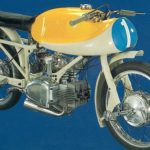This short article recounts the history of Moto RUMI in a little more detail and is for all those who greeted the news of cooperation between Clay Paky and Rumi Sport Racing Engineering with enthusiasm and interest. Our cooperation regards the development of the new 250cc four-stroke engine for international Moto 3 class races.
The RUMI foundry was founded by Mr Stefano Rumi’s grandfather in Bergamo (Italy) at the beginning of the 20th century. During World War II, the foundry was converted to the manufacture of marine propellers, periscopes, torpedoes and various other weapons. This explains Rumi’s historic trademark: a marine propeller, an anchor and a periscope.
After the war, the company started to design and manufacture textile machinery and – especially – light motorcycles under the management of Mr Donnino Rumi, Stefano’s father. In a nutshell, RUMI became one of the Italian companies that contributed to the country’s motorization.
The SCOIATTOLO (=squirrel) and FORMICHINO (=little ant) motor scooters became very famous and had huge commercial success (see photos), but there were also many touring and cross-country motorcycle models.
In 1954, a super sport racing bike called the GOBBETTO (=hunckback) won the Italian Speed Championship (see photographs). In 1957, 1958 and 1960, RUMI won the 125 and 175cc scooter classes in the famous Bol d’Or twenty-four hour endurance race, which took place in Montlhéry, France.
In 1988 and1989, the Californian rider Fred Merkel led the RUMI race team to winning the Superbike World Championship.
Mr Stefano Rumi has inherited the passion for motorcycles from his dad. In 2009, he founded Rumi Sport Racing Engineering, a company devoted to designing and manufacturing race engines and motorcycles. In 2010 and 2011, the company took part in the Italian Speed Championship, in the 125cc two-stroke class, with a motorcycle designed and built entirely in-house. The young Japanese rider Hiroki Ono rode it to fourth place at the Vallelunga Circuit, bringing home the best result in the 2011 season.
We are now entering the racing department, where both the reed and rotary valve 125cc two-stroke engines were designed and manufactured. This is also where the 250cc four-stroke engine, whose sound you can hear while it is “warming up” for the track in a few months time (video and audio), was conceived and put together in 2012.
We’ll see you at the track. However it goes, it will be a pleasure!





